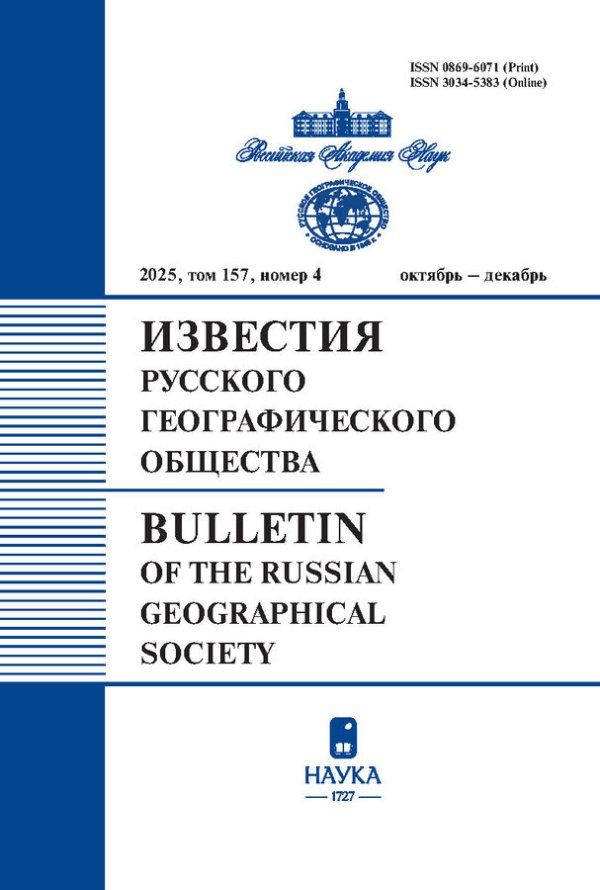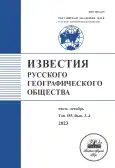Seasonal and Inter-Annual Variability of Water Temperature in Petrozavodsk Bay of Lake Onega
- Authors: Zdorovennova G.E.1, Zdorovennov R.E.1, Palshin N.I.1, Efremova T.V.1
-
Affiliations:
- Institute for Water Problems of the North, Karelian Research Center, Russian Academy of Sciences
- Issue: Vol 155, No 3-4 (2023)
- Pages: 47-61
- Section: Articles
- URL: https://journals.rcsi.science/0869-6071/article/view/254225
- DOI: https://doi.org/10.31857/S0869607123030126
- EDN: https://elibrary.ru/RRKKBK
- ID: 254225
Cite item
Full Text
Abstract
Abstract—
Based on year-round measurements of water temperature at an autonomous station (an anchored chain equipped with temperature sensors), the features of the temperature and ice regimes of the Petrozavodsk Bay of Onega Lake in modern climatic conditions were studied; the dates and duration of the main hydrological phenomena in the water area of the bay were specified. In the abnormally warm winter of 2019–2020, the water area of the Petrozavodsk Bay was not completely covered with ice for the first time in a long period of observations; in the area of the measurement station, ice fields were observed from late January to mid-March. The duration of ice-covered period in the next two winters was 3.5 and 5 months. Data were obtained on the timing of the onset and duration of the spring under-ice convection, a phenomenon that plays an important role in the thermal regime of the lake at the end of winter. It is shown that 2016, 2021 and 2022 spring under-ice convective mixing lasted 4–6.5 weeks, covering the entire water column by the end of ice period. Mixing of the water column after breaking the ice (spring homothermy) continued for another 3–4 weeks. In the spring of 2020, under-ice convection was not observed; spring overturn continued for two months from mid-March to mid-May. The dates of the upward transition of water temperature through 4°C in the years of measurements (5–19 May) were ahead of the long-term average by 2–3 weeks (end of May). Thermal stratification was established from 12 to 27 May and existed for 3–3.5 months. Complete mixing of the water mass of the bay took place in late August–early September, and then, until ice settling, the water column cooled in a state of homothermy. Immediately before ice formation, the water temperature dropped to very low values and did not exceed 0.1°С in the water column. The period with an average daily water temperature of the surface layer of the Petrozavodsk Bay above 10°C lasted from 121 to 144 days during the years of measurements.
About the authors
G. E. Zdorovennova
Institute for Water Problems of the North, Karelian Research Center, Russian Academy of Sciences
Author for correspondence.
Email: zdorovennova@gmail.com
Russia, Petrozavodsk
R. E. Zdorovennov
Institute for Water Problems of the North, Karelian Research Center, Russian Academy of Sciences
Author for correspondence.
Email: romga74@gmail.com
Russia, Petrozavodsk
N. I. Palshin
Institute for Water Problems of the North, Karelian Research Center, Russian Academy of Sciences
Author for correspondence.
Email: npalshin@mail.ru
Russia, Petrozavodsk
T. V. Efremova
Institute for Water Problems of the North, Karelian Research Center, Russian Academy of Sciences
Author for correspondence.
Email: efremova@nwpi.krc.karelia.ru
Russia, Petrozavodsk
References
- Efremova T.V., Pal’shin N.I., Belashev B.Z. Water temperature in different types of lakes in Karelia under changing climate based on data of instrumental measurements in 1953–2011 // Water Resources. 2016. Т. 43. № 2. P. 402–411.
- Zdorovennova G.E., Gavrilenko G.G., Zdorovennov R.E. et al. E’volyuciya temperatury vodnoj tolshhi boreal’nyh ozer na fone izmenenij regional’nogo klimata // Izvestiya RGO. 2017. T. 149. Vyp. 6. S. 59–74.
- Zdorovennova G.E., Golosov S.D., Pal’shin N.I. et al. Zimnij termicheskij i ledovyj rezhimy malyh ozer karelii na fore regional’noj klimaticheskoj izmenchivosti // Vestnik Sankt-Peterburgskogo unichersiteta. Nauki o Zemle. 2022. T. 67. № 1. S. 138–155. https://doi.org/10.21638/spbu07.2022.108
- Kalinkina N.M., Tekanova E.V., Efremova T.V. et al. Reakciya ekosistemy Onezhskogo ozera v vesenne-letnij period na anomal’no vysokuyu temperaturu vozduxa zimy 2019–2020 godov // Izvestiya RAN. Seriya geograficheskaya. 2021. T. 85. № 6. S. 888–899. https://doi.org/10.31857/S2587556621060078
- Krupnejshie ozera-vodoxranilishha Severo-Zapada Evropejskoj territorii Rossii: sovremennoe sostoyanie ekosistem pri klimaticheskix i antropogennyx vozdejstviyax. Petrozavodsk KarNC RAN, 2015. 375 s.
- Nazarova L.E. Klimaticheskie usloviya na territorii Karelii // Sovremennye issledovaniya vodoemov Severa. Uchebnoe posobie. Petrozavodsk: KarNC RAN, 2021. S. 7–16.
- Palshin N.I., Zdorovennova G.E., Zdorovennov R.E. et al. Effect of under-ice light intensity and convective mixing on chlorophyll a distribution in a small mesotrophic lake // Water Resources. 2019. Т. 46. № 3. P. 384–394.
- Raspisanie pogody. Sajt. RP5.ru. URL: https://rp5.ru/. Data obrashheniya 15 fevralya 2023 g.
- Reznikov A.I., Isachenko G.A. Izmeneniya klimatichvkix xarakteristik zapadnoj chasti tajgi Evropjskoj Rossii v konce XX–nachale XX vv. // Izvestiya RGO. 2021. T. 153. Vyp. 1. S. 3–18. https://doi.org/10.31857/S0869607121010055
- Tixomirov A.I. Termika krupnyh ozer. L.: Nauka, 1982. 232 s. Tretij ocenochnyj doklad ob izmeneniyax klimata i ix posledstviyax na territorii Rossijskoj Federacii. Rosgidromet. SPb: Naukoemkie texnologii. 2022. 676 s.
- Tretij ocenochnyj doklad ob izmeneniyax klimata i ix posledstviyax na territorii Rossijskoj Federacii. Rosgidromet. SPb: Naukoemkie texnologii. 2022. 676 s.
- Bouffard D., Zdorovennova G., Bogdanov S. et al. Under-ice convection dynamics in a boreal lake // Inland Waters. 2019. Vol. 9. № 2. P. 142–161. https://doi.org/10.1080/20442041.2018.1533356
- Desgué-Itier O., Melo Vieira Soares L., Anneville O. et al. Past and future climate change effects on the thermal regime and oxygen solubility of four peri-alpine lakes // Hydrol. Earth Syst. Sci. 2023. Vol. 27. P. 837–859. https://doi.org/10.5194/hess-27-837-2023.
- Engelhardt С., Kirillin G. Criteria for the onset and breakup of summer lake stratification based on routine temperature measurements, Fundam. Appl. Limnol. 2014. Vol. 184 (3). P. 183–194. https://doi.org/10.1127/1863-9135/2014/0582
- Jane S.F., Hansen G.J.A., Kraemer B.M. et al. Widespread deoxygenation of temperate lakes // Nature. 2021. Vol. 594. P. 66–70. https://doi.org/10.1038/s41586-021-03550-y
- Multimaps. Сайт. URL: https://multimaps.ru. Date of access 15 February 2023.
- O’Reilly C.M. et al. Rapid and highly variable warming of lake surface waters around the globe // Geophys. Res. Lett. 2015. 42. 24. 10773–10781. https://doi.org/10.1002/2015GL066235
- Sharma S., Blagrave K., Magnuson J.J. et al. Widespread loss of lake ice around the Northern Hemisphere in a warming world // Nat. Clim. Chang. 2019. Vol. 9. № 3. P. 227–231. https://doi.org/10.1038/s41558-018-0393-5
- Suarez E., Tiffay M.-C., Kalinkina N. et al. Diurnal variation in the convection-driven vertical distribution of phytoplankton under ice and after ice-off in large Lake Onego (Russia) // Inland Waters. 2019. Vol. 9. № 2. P. 193–204. https://doi.org/10.1080/20442041.2018.1559582
- Winder M., Schindler D.E. Climate Change Uncouples Trophic Interactions in an Aquatic Ecosystem // Ecology. 2004. Vol. 85. № 8. P. 2100–2106. https://doi.org/10.1890/04-0151
- Wüest A., Pasche N., Ibelings B. et al. Life under ice in Lake Onego (Russia) – an interdisciplinary winter limnology study // Inland waters. 2019. Vol. 9. № 2. P. 125–129. https://doi.org/10.1080/20442041.2019.1634450
Supplementary files











